Birders visiting Thailand usually have a variety of targets, wishes and criteria for a successful trip. However, a number of species feature highly on most trip target lists. Over the years, the following species consistently appear as the top 25 most sought after species. Information on this page checked/updated as of 6 Sep 2024.
1 |
Coral-billed Ground Cuckoo
Carpococcyx renauldi
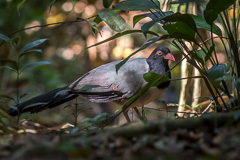
|
This, the most desired bird in Thailand, whilst being resident in accessible protected forests, is none the less rather tricky to actually find. Uncommon and shy. Although the species also occurs in several other protected areas, such as Khao Soi Dao and Phu Khieo wildlife sanctuaries, undoubtedly the best place to find it is Khao Yai National Park. In some years birds are attracted to the kitchens near the headquaters or campsites. This bird occurs along most trails in the park, as well as the lower sections of the road to the Khao Khieo viewpoint. If no birds are staked-out, time, effort and luck are required.
|
| 2 |
Giant Nuthatch
Sitta magna
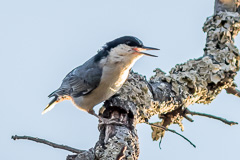
|
Of the top five species, Giant Nuthatch is probably the easiest to encounter. The traditional site to find it was Doi Chiang Dao, though numbers have declined here in recent years for reasons unknown. The species prefers mature pine trees within mixed forest. At Chiang Dao, the best strategy is an early start, to arrive at the DYK sub-station campsite near the top of Doi Chiang Dao at dawn. The species is often vocal early morning around the campsite, or anywhere along the road down from the campsite for at least 5-6 kilometres. Due to the road condition this is best attempted in the dry season. This species is now more regularly recorded in similar habitat on the western slope of Doi Lang. Additionally the bird occurs some winters at Doi Ang Khang; either in pines along the ridge road from around Km 19 to Km 21, or in mixed pines down the Arunothai road above Km 35. It can also be found on Doi Kham Fa (between Chiang Dao and Ang Khang).
|
| 3 |
Mrs. Hume's Pheasant
Syrmaticus humiae
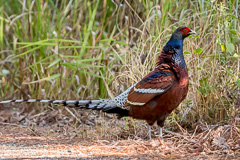
|
A speciality of Doi Ang Khang, Doi Lang and Doi Chiang Dao. This bird occurs in the undergrowth of mixed pine-oak forest. It is most easily seen in the later dry season, as the understorey will have died back or been burnt off in the annual forest burning, which plagues the north of Thailand. It is uncommon, and usually repeated visits are required to come to grips with it. At Doi Ang Khang it can be found along the Arunothai road, from about Km 40 downward, and is occasionally reported along the ridge road or firebreak trails. At Doi Chiang Dao it occurs along the road from the DYK sub-station campsite back toward the upper checkpoint for several kilometres. At Doi Lang the bird is mostly encountered on the western slope along the road, or much more reliably when visiting photographers bait the bird early morning. However, the Department of National Park is trying to stamp out this practice. The bird has occasionally been seen in higher parts of Doi Suthep-Pui National Park.
|
| 4 |
Spoon-billed Sandpiper
Calidris pygmeus

|
This critically endangered species has undergone a rapid decline in numbers, with the worldwide population now estimated to be only 500-800 individuals. Thailand, being one of its regular wintering areas, is a good place to see it, as it is still currently annual on the Gulf coast. The main area to search are the salt pans at Pak Thale, where a few individuals can often be found, especially at high tide. Additionally it can sometimes to found at the nearby Laem Phak Bia, either on the sand spit or the salt pans, as the birds commute between there and Pak Thale for feeding. Birds usually arrive toward the end of October and depart during April, with stragglers recorded into May. It is also regular farther north at the salt pans around Khok Kham and has been recorded down the coast at Khao Sam Roi Yot.
|
| 5 |
Blue Pitta
Hydrornis cyaneus

|
Although widespread, this pitta, like its congeners can be difficult to find. As with all pittas, finding it is best done at the start of the breeding season when they are vocal - usually March to June. It occurs in a number of national parks, but is most often found at Kaeng Krachan in the region of the river crossings beyond the Ban Krang campsite. They sometimes also appear at the private hides around Kaeng Krachan. Khao Yai National Park is also a good place search, with birds at all elevations of forest within the park. Also Nam Nao National Park and Mae Wong National Park.
|
| 6 |
Nordmann's Greenshank
Tringa guttifer
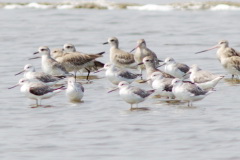
|
Another endangered wader with a low and decreasing population, wintering in Thailand. The easiest place to observe it is the salt pans at Laem Phak Bia where most years about 50 birds winter. The species has a strong association with Great Knot, so scanning the easier to find Great Knot flocks is the best way of initially picking out this bird. It is also regular at sites farther south, particularly Khao Sam Roi Yot National Park and the river mouth at Krabi.
|
| 7 |
White-faced Plover
Charadrius dealbatus
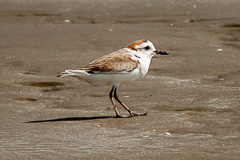
|
The taxonomic status of this rather distinct taxon has a long history and until recently was considered a subspecies of Kentish Plover. Clearly the bird is rare, with breeding known only from southeast China and Vietnam, and wintering records from Thailand, Malaysia, Singapore, Vietnam and Sumatra. In Thailand the bird is only regularly recorded at Laem Phak Bia between late October and March, where a bird or two are regularly found on the sand spit, or occasionally on the salt pans. Its occurrence though can be frustratingly inconsistent, and repeated trips can be required to find it. When the birds moult into breeding plumage during March they can be easy to pick out, but in non-breeding plumage are easily overlooked as either Malaysian Plover or even Tibetan Sand Plover, rather than, as might be expected, Kentish Plover. Despite the marked morphological differences, genetic study has shown, rather unexpectedly, that its DNA is virtually identical to the nominate form of Kentish Plover, ensuring its taxonomic position will likely remain contentious. See article on genetic study.
|
| 8 |
White-fronted Scops Owl
Otus sagittatus
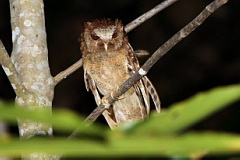
|
Patchily distributed in peninsula Burma, Thailand and Malaysia, this owl is hard to find everywhere. Previously, in Thailand it was most readily found at Khao Nor Chuchi, but has become mostly impossible there of late. Currently the best place to search is the forest between the stream crossings at Kaeng Krachan National Park above the Ban Krang campsite. However, walking here at night is not permitted due to the potential of large animals in the same area. It is also fairly reliable at Hala-Bala Wildlife Sanctuary, but not only is this area far off the usual birding track, the insurgency issues in southern Thailand put off many potential visitors.
|
| 9 |
Eared Pitta
Hydrornis phayrei
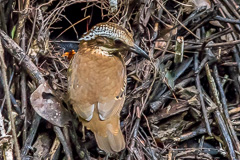
|
Generally the most accessible and easiest place to see this bird is Khao Yai National Park. Despite being widespread there it is rare and frustratingly difficult to find. Adding to the problem, this species is not very vocal. It is most often found from June to August when breeding. It is present on all forest trails, and forest along lower sections of the road to the Khao Khieo viewpoint. The species also occurs at Kaeng Krachan where, in the wet season around July, locals sometimes find nesting individuals and set up temporary hides for photographers.
|
| 10 |
Siamese Fireback
Lophura diardi
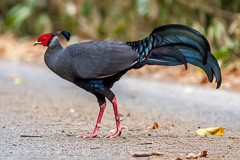
|
For ease of access, Khao Yai National Park is the place to search for this impressive pheasant. In earlier years, sightings could be almost guaranteed, but as with many species these days, sightings are less frequent. However Khao Yai still remains a good locality, with the lower sections of the road to the Khao Khieo viewpoint a regular spot. Other trails in the park, anywhere near the HQ, have regular sightings. However, for almost guaranteed sightings the best locality is Sakaerat Biosphere Reserve east of Khao Yai. The main issue here is arranging access, either directly with the Reserve or a local guide, as the reserve is not open to the public. If access can be gained, the firebacks, which are not particularly shy here, are usually present along the first part of the main track through the reserve shortly after the HQ buildings.
|
| 11 |
Long-tailed Broadbill
Psarisomus dalhousiae
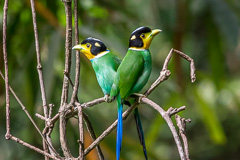
|
Of all the broadbills in Thailand, the Long-tailed Broadbill seems to impress visitors the most. Although not common, the bird is sufficiently widespread that the chances of running into a small group is fairly high. It is found in a variety of forest types, mainly at mid elevations. Sites where it is frequently encountered include Kaeng Krachan and Khao Yai national parks in central areas, and Doi Inthanon, Doi Lang and Doi Chiang Dao in the north.
|
| 12 |
Silver Pheasant
Lophura nycthemera
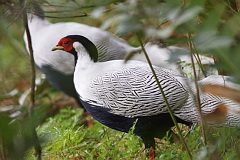
|
Both spectacular and tricky to find. The two most regular spots for Silver Pheasant are the trail network along the streams behind the campsite at Nam Nao National Park and the upper section of road to Khao Khieo in Khao Yai National Park. Other than that, the bird is present on many of the mountains of the north but is invariably seen only by chance. Places to look include Doi Inthanon, Chiang Dao and Doi Lang. The distinctive southeastern race can be found at Khao Soi Dao Wildlife Sanctuary. Its counterpart, the Kalij Pheasant of the western side of Thailand, can most readily be found at Kaeng Krachan National Park, particularly at the commercial bird hides outside the park, but also occurs in Mae Wong National Park.
|
| 13 |
Baer's Pochard
Aythya baeri
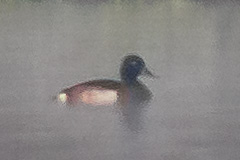
|
The world population of this endangered duck is undergoing a catastrophic decline. According to an article in OBC Birding Asia 18, December 2012, the population may now number only 100 individuals and extinction is probable within a few years. In the 1980's groups of hundreds could be found in Thailand. Numbers of wintering birds have now dwindled to a few random sightings, primarily at Chiang Saen, Bueng Boraphet and the rarely visited Bung Khong Long. Birds usually occur between November and February, but often do not remain in an area. Sightings of single birds at Chiang Saen are no longer annual and this site can no longer be relied upon for this bird. In recent years a few birds have occured at Bueng Boraphet in the Spring, though access here requires a boat and finding the small numbers of diving ducks here can be a challenge due to the immense size of the lake.
|
| 14 |
Rail-babbler
Eupetes macrocerus
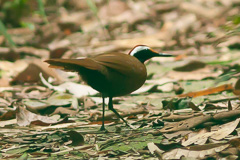
|
Another forest species tricky to observe. Only two sites are currently known for this species - Hala-Bala Wildlife Sanctuary and the Krung Ching area of Khao Luang National Park. At least one pair had an established territory along the waterfall trail at Krung Ching, and was a favourite target of photographers for a large part of the year. Of late though the birds are only infrequently found. This bird's distinctive song is the most reliable way to locate it. National park staff at Krung Ching are usually aware if the birds have been seen recently.
|
| 15 |
Slaty-backed Forktail
Enicurus schistaceus
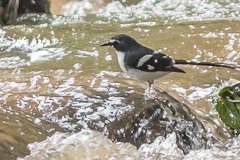
|
This species is widespread, though often elusive. Within Doi Inthanon National Park it can sometimes be found at the Wachirathan Waterfall or the river at Mae Pan. Other regular sites are Doi Lang, Doi Ang Khang, Doi Pha Hom Pok, Doi Chiang Dao and, further afield, Phu Suan Sai National Park.
|
| 16 |
Giant Pitta
Hydrornis caeruleus
|
Whilst high on want lists, this is probably the least encountered pitta in Thailand, with no reliable sites. It is infrequently recorded in lowland evergreen forest at Hala-Bala Wildlife Sanctuary, Khao Phra Bang Khram Wildlife Sanctuary and, very rarely, Kaeng Krachan National Park. |
| 17 |
Ratchet-tailed Treepie
Temnurus temnurus
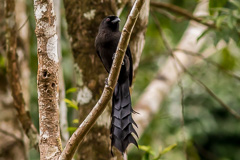
|
The scarce Ratchet-tailed Treepie occurs only in Burma and Vietnam plus an isolated population on the mountain in Kaeng Krachan National Park. At Kaeng Krachan it seems to have a very restricted altitude range and should be looked for between the Km 27 marker and the campsite at the pass. Time and patience are required as many visits can be required to find it, probably due in part to this being neither a very vocal nor active species. Note that upper elevations of the park are closed between 1 Aug and 31 Oct annually.
|
| 18 |
Grey Peacock-Pheasant
Polyplectron bicalcaratum
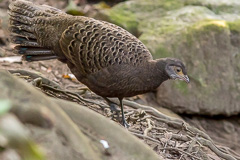
|
The Grey Peacock-Pheasant is findable in Mae Wong and Kaeng Krachan national parks. In Kaeng Krachan it is most often encountered between February and April when the birds are active and vocal. Sightings are often chance encounters of birds crossing the road, usually in the area above Ban Krang camp site. From time to time it also visits the commercial hides outside the park. At Mae Wong the birds are sometimes enticed to feeding areas - usually around the Chong Yen campsite in the dry season.
|
| 19 |
Jerdon's Bush Chat
Saxicola jerdoni
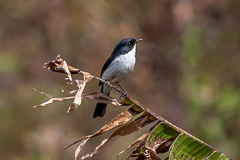
|
For most visitors, finding Jerdon's Bush Chat is a lot harder than it should be. Due to its main distribution being well away from frequently visited birding spots, most struggle, and by necessity look in areas where it is rather uncommon. The species is common only in the northeast of the country, particularly the northeast of Loie province. Nearer to most visitors path, it can also be found on the slopes of Phu Hin Rong Kla National Park. However, in the absence of time, looking along the Mekong and Mekok Rivers in northwestern Thailand are the only other alternatives. Traditionally the bird has been most findable at Thaton in rank grass along the river east of town, where it still occurs but is by no means readily found. A pair were, until a few years ago, seen in the rice paddies half way up Doi Lang's eastern slope, but appear to have deserted the area. If visiting Chiang Saen, a drive along the Mekong east of town toward Chiang Khong and scanning rank vegetation along the Mekong can produce the bird, usually after at least 25 kilometres from Chiang Sean.
|
| 20 |
Mangrove Pitta
Pitta megarhyncha
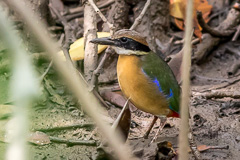
|
Finding Mangrove Pitta is primarily a question of time of year. Outside the breeding season it is extremely difficult to encounter, but during the breeding season from May to July it is easily found at a number of mangrove spots in the south. An excellent site is the mangrove walkway at Krabi. It can also be found at all the mangrove walkways around Phang-nga, including Ao Phang-nga National Park, as well as further south at Khao Lampi - Hat Thai Mueang National Park.
|
| 21 |
Purple Cochoa
Cochoa purpurea
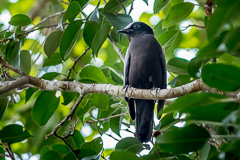
|
Without question a very tough species to encounter. The most regular spots, in the past, seemed to be the Jeep Tracks at Km 37 and Km 34 on Doi Inthanon, but recent sightings have all but dried up. Both Thai cochoa species are very difficult to find outside the wet season, and as the Purple Cochoa is much rarer it can only realistically be expected at that time. Other mountains where it has been recorded include Doi Ang Khang, Doi Lang, Doi Tung and Doi Phu Kha.
|
| 22 |
Tickell's Brown Hornbill
Anorrhinus tickelli
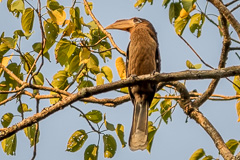
|
Restricted to Burma and southern Thailand, this species is only readily accessible at Kaeng Krachan National Park. It is most easily found from February to April when breeding, and photographers are often aware of a nest location, usually between the stream crossings above the Ban Krang camp site. Even outside the breeding season birds can often be found in the same area, although they also wander to other parts of the park, so can be missed. It's eastern counterpart, Austen's Brown Hornbill, occurs in Phu Khieo Wildlife Sanctuary and Khao Yai National Park but is rare and difficult to find at the later. One place to search is the road up to the Khao Khieo viewpoint or the upper parts of the paved Nature Trail behind the headquarters.
|
| 23 |
Rufous-collared Kingfisher
Actenoides concretus
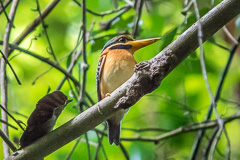
|
Widespread in the southern half of Thailand, but thin on the ground, requiring good lowland forest with clean streams. It has been recorded along the rivers at Kaeng Krachan National Park, as well as along the rivers at Khao Sok National Park, Khao Luang National Park, Sri Phang-nga National Park and Hala-Bala Wildlife Sanctuary.
|
| 24 |
Great Hornbill
Buceros bicornis
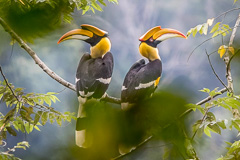
|
The largest hornbill in Thailand. Despite its size this bird is thankfully one of the more common hornbills and can be found in small groups in a number of parks. Good localities include Kaeng Krachan National Park, Khao Yai National Park, Thaleban National Park, Sri Phang-nga National Park, Khao Sok National Park and Khao Soi Dao Wildlife Sanctuary.
|
| 25 |
Gurney's Pitta
Hydrornis gurneyi

(Ian Dugdale)
|
Originally vying for top spot, this jewel of the forest understorey, has a chequered history and was declared functionally extirpated in Thailand at the end of 2014, although a single female was recorded in 2016. Historically known only from peninsula Burma and Thailand the species became lost until its rediscovery in 1986 at Khao Nor Chuchi in the Khao Phra Bang Khram Wildlife Sanctuary. From an initial 40 plus pairs, the conservation and protection of this bird made sorry reading and a sad story for what should have been a flagship for conservation in Thailand. A lack of effective protection for both the species and its habitat resulted in numbers dwindling slowly to zero. Further hope, at least outside Thailand, for this species came with the discovery of more than 5,000 pairs at a few sites in southern Burma in 2003. Unfortunately for birders, these areas are not that accessible and that population is now also in decline due to forest clearance for oil palm and rubber.
|
























